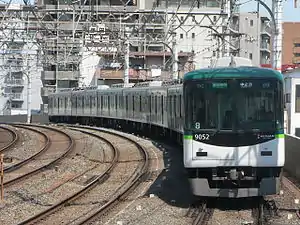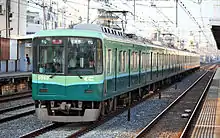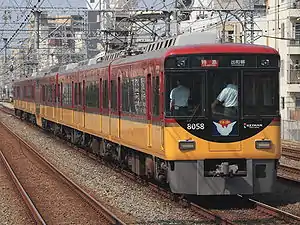Keihan 9000 series
The Keihan 9000 series (京阪9000系, Keihan 9000-kei) is an electric multiple unit (EMU) commuter train type operated by the private railway operator Keihan Electric Railway in Kyoto, Japan, since 1997.[1]
| Keihan 9000 series | |
|---|---|
 8-car set 9002 in May 2010 | |
| Manufacturer | Kawasaki Heavy Industries |
| Built at | Kobe |
| Entered service | 1997 |
| Number built | 40 vehicles (5 sets) |
| Number in service | 36 vehicles (5 sets, the rest of 4 vehicles were converted to 10000 series) |
| Formation | 7/8 cars per trainset |
| Fleet numbers | 9001–9005 |
| Operator(s) | Keihan Electric Railway |
| Specifications | |
| Car body construction | Aluminium |
| Car length |
|
| Width | 2,780 mm (9 ft 1 in) |
| Height | 4,185 mm (13 ft 8.8 in) |
| Doors | 3 pairs per side |
| Maximum speed | 110 km/h (70 mph) |
| Traction system | Variable frequency (GTO) |
| Electric system(s) | 1,500 V DC |
| Current collection method | Overhead wire |
| Safety system(s) | Keihan ATS |
| Track gauge | 1,435 mm (4 ft 8 1⁄2 in) |
Design
The 9000 series trains were developed from the earlier 7200 series trains introduced in 1995.[1]
Formations
As of 1 April 2015, the fleet consists of four eight-car sets and one seven-car set.[2] The fleet originally consisted of five eight-car sets, but one set, 9001, was reduced to seven cars in 2015.[2]
8-car sets
The eight-car sets are formed as follows, with four motored ("M") cars and four non-powered trailer ("T") cars.[2]
| Designation | Mc1 | T1 | T2 | M2 | M1 | T3 | T4 | Mc2 |
|---|---|---|---|---|---|---|---|---|
| Numbering | 900x | 950x | 960x | 910x | 915x | 955x | 965x | 905x |
- "Mc" cars are motored driving cars (with driving cabs).
- "M" cars are motored intermediate cars with driving facilities at one end for depot shunting.[2]
- "T" cars are unpowered trailer cars.
- The Mc and M cars each have one scissors-type pantograph.[2]
- The 9500 cars are designated as "mildly air-conditioned" cars.[2]
7-car sets
The reformed seven-car set, 9001, is formed as follows, with three motored ("M") cars and four non-powered trailer ("T") cars.[2]
| Designation | Mc1 | T1 | T6 | M3 | T3 | T4 | Mc2 |
|---|---|---|---|---|---|---|---|
| Numbering | 900x | 950x | 970x | 915x | 955x | 965x | 905x |
- "Mc" cars are motored driving cars (with driving cabs).
- "M" cars are motored intermediate cars with driving facilities at one end for depot shunting.[2]
- "T" cars are unpowered trailer cars.
- The "T6" car has driving facilities at one end for depot shunting.[2]
- The Mc and M cars each have one scissors-type pantograph.[2]
- The 9500 car is designated as "mildly air-conditioned" cars.[2]
Interior
Passenger accommodation originally consisted of a mixture of fixed transverse seating and longitudinal bench seating, but seating was converted to longitudinal seating only from 2008.[1]
 The original transverse seating in July 2007
The original transverse seating in July 2007 Longitudinal seating in refurbished set 9005 in December 2008
Longitudinal seating in refurbished set 9005 in December 2008
History

The first trains entered revenue service in 1997.[1]
In March 2015, set 9001 was reformed as a seven-car set.[2] Cars 9601 and 9602, removed from sets 9001 and 9002 when they were reduced to seven cars, were subsequently renumbered 10701 and 10751 respectively and inserted into 10000 series EMU set 10001 in February 2016 when that set was lengthened from four to seven cars.[3]
References
- 私鉄車両年鑑2013 [Japan Private Railways Annual 2013] (in Japanese). Tokyo, Japan: Ikaros Publications Ltd. 20 March 2013. p. 82. ISBN 978-4-86320-693-9.
- 私鉄車両編成表 2015 [Private Railway Rolling Stock Formations - 2015] (in Japanese). Japan: Kotsu Shimbunsha. 23 July 2015. p. 132. ISBN 978-4-330-58415-7.
- 京阪10000系10001編成が7連化されて試運転 [Keihan 10000 series set 10001 lengthened to seven cars and test-run]. Japan Railfan Magazine Online (in Japanese). Japan: Koyusha Co., Ltd. 18 February 2016. Retrieved 19 February 2016.
External links
| Wikimedia Commons has media related to Keihan 9000 series. |
- Official website (in Japanese)
